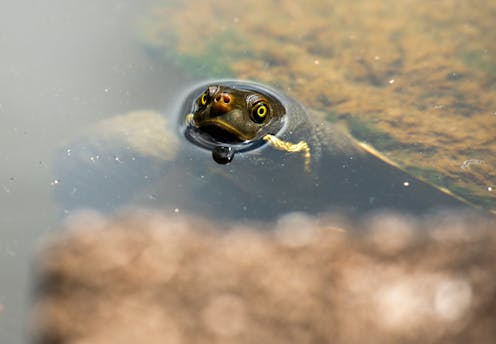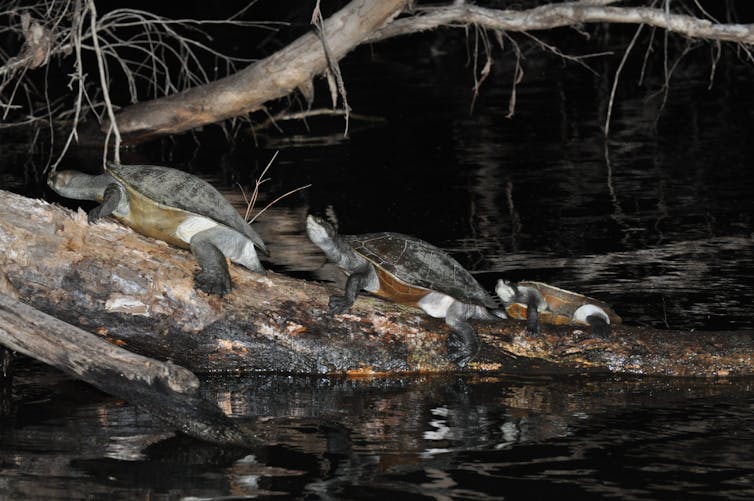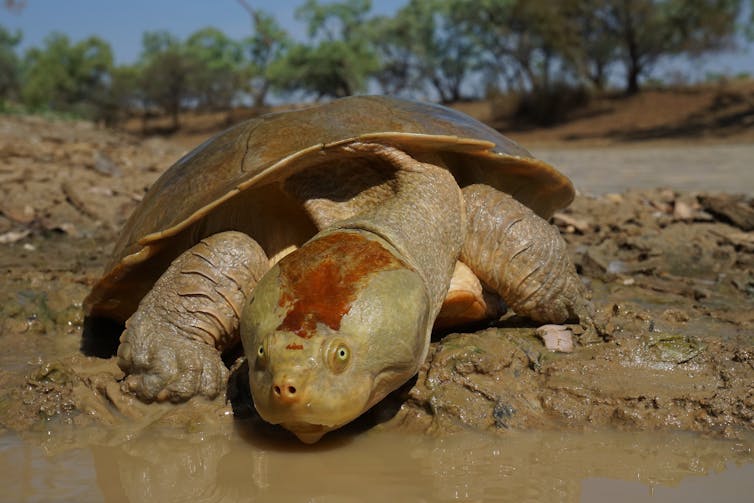Source: The Conversation (Au and NZ) – By Deborah Bower, Associate Professor in Zoology and Ecology, University of New England

Rob D the Pastry Chef, Shutterstock
Australian freshwater turtles support healthy wetlands and rivers. Yet one in three turtle species is threatened with extinction. And there is still much we don’t know about them.
In today’s special issue of the journal Austral Ecology, 55 authors present the latest research on Australian freshwater turtles.
Along with other biologists, we have contributed to a series of research papers to inform ecology and conservation of freshwater turtles.
Our research reveals some fresh insights into turtle behaviour, survey methods and conservation strategies.
Read more:
There’s a thriving global market in turtles, and much of that trade is illegal
Spy wear and other turtle tech
In one study researchers compared data from underwater video cameras to traditional trapping surveys and achieved similar results. They detected 83 turtles from 52 hours of footage and identified all species in the study area.
Overall, baited remote underwater videos proved to be a “useful, time effective, non-invasive technique to collect relative abundance and species richness estimates for freshwater turtles”.
Another study provided the first vision of a wild saw-shelled turtle attempting to court a mate. The male sought affection from the female turtle by waving his feet and pressing his nose into her face.

Donald McKnight
Meanwhile, a different male was observed trying to mount a larger male. This was the first case of same-sex mounting seen in this species.
We are continuing to unravel curious turtle behaviour known as nocturnal basking. During the day, many reptiles regulate their body temperature by sunning themselves. But some freshwater turtles (and crocodiles) also emerge from the water and bask on logs at night.
To find out why, scientists in Queensland measured the preferred temperature of Krefft’s river turtles and watched them bask more when the water was hot. So it seems they do this to stay cool in hot weather.

Eric Nordberg
Over in desert country, we recaptured Cooper Creek turtles after two decades. While we were there, the site became surrounded with floodwater – this provided a rare opportunity to find turtles moving onto the floodplain to find food.
We also found lots of baby turtles. This is in contrast to most places around Australia, which have ongoing problems with foxes eating turtle nests.

Donald McKnight
Conservation success stories
Foxes target freshwater turtle nests across Australia, reducing breeding success. Researchers are experimenting with measures to protect nests from predators.
In the New England Tablelands, temporary electric fences served to protect turtle nests from foxes over three breeding spring-summer seasons from 2019 to 2022. But in the Murray River, plastic mesh over individual nests only protected some of them.
Nest protection supports conservation of the endangered Mary River turtle. Over 22 years, more than 100 members of the local community in the Mary River Catchment have led initiatives to protect Mary River turtles. Working with communities has dual benefits – for research and for the people involved, who enjoy connecting to nature.
These collaborations have helped improve river management, informing delivery of water for the environment and improving the quality of river habitats for turtles.
November is Turtle Month for the 1 Million turtles campaign, a national citizen science program bringing together scientists and the community, to support freshwater turtle conservation initiatives.
Through the free TurtleSAT app, people can do more than just report turtle sightings. They can actively contribute to data-driven turtle management.
The app provides real-time data visualisation. The program website also provides education, helping citizen scientists protect nests, establish predator-free turtle sanctuaries, engage in national experiments, and deepen their understanding of turtles and wetlands.
With more than 18,000 records logged, 1,200 turtles saved from road hazards and 500 nests protected, this initiative is crucial in light of the growing threats faced by freshwater turtle species.
Read more:
Our turtle program shows citizen science isn’t just great for data, it makes science feel personal
Challenges and solutions
Of Australia’s 25 freshwater turtle species, 12 are so poorly known their national conservation status could not be assessed during this 2022 review. Many of these lesser-known species occur in northern Australia.
Of the 15 species or subspecies assessed, we recommended listing a higher level of threat for eight. This included western saw-shelled turtles, which were recently uplisted from vulnerable to endangered.
Threats include habitat loss, being eaten by foxes or feral pigs, disease, fire, and moving species into new areas where they breed with existing turtle species. To manage these threats, we need to move beyond engagement to an integrated approach, where conservation advice is co-determined by First Nations people who are closely involved in implementing recovery plans and action plans.
There is immense value in establishing long-term studies to track these long-lived species. And technology continues to provide new opportunities to learn more.
Future conservation and management will require working with communities to learn more about turtles and protect them. If one million people each save one turtle, collectively we will have made a big difference.
Read more:
Turtles on the tarmac could delay flights at Western Sydney airport
![]()
Deborah Bower receives funding from the Australian Research Council, NSW Department of Environment and Planning, and the Northern Tablelands Local Land Services.
Donald McKnight works for the Savanna Field Station and received funding from the Australian Society of Herpetologists and Winifred Violet Scott Charitable Trust.
Eric Nordberg receives funding from the National Environmental Science Program Landscape Hub, Australian Departments of Environment and Planning, and Northern Tablelands Local Land Services.
James Van Dyke receives funding from the Australian Research Council and the Australian Department of Industry, Science and Resources.
Michael B Thompson has received funding for turtle research from the Australian Research Council. He is also involved with the 1 Million Turtles program funded by a Commonwealth Citizen Science grant.
Ricky Spencer receives funding from the Australian Research Council, WIRES and Department of Industry, Science and Resources.
– ref. Moonlight basking and queer courting: new research reveals the secret lives of Australian freshwater turtles – https://theconversation.com/moonlight-basking-and-queer-courting-new-research-reveals-the-secret-lives-of-australian-freshwater-turtles-215531







